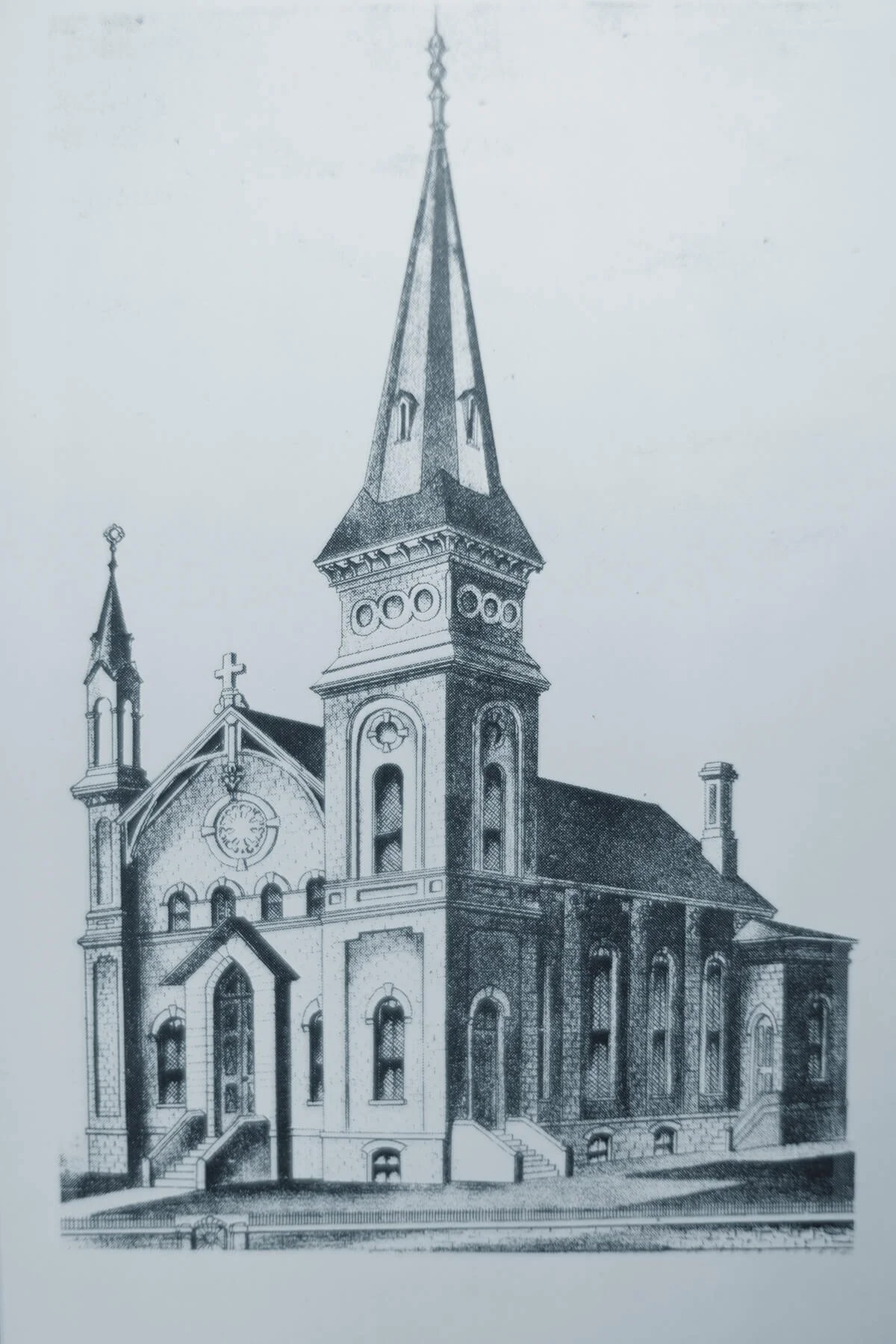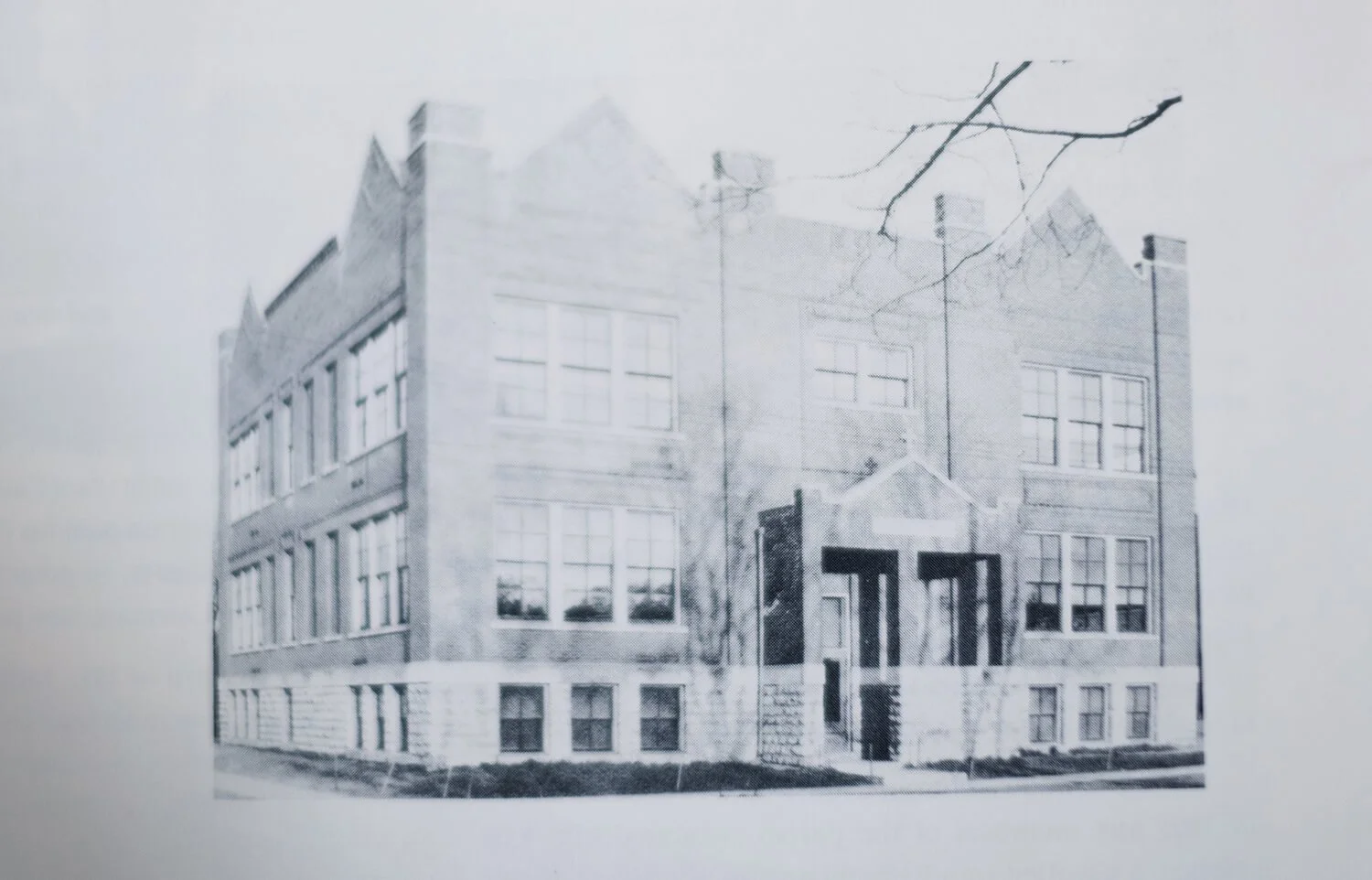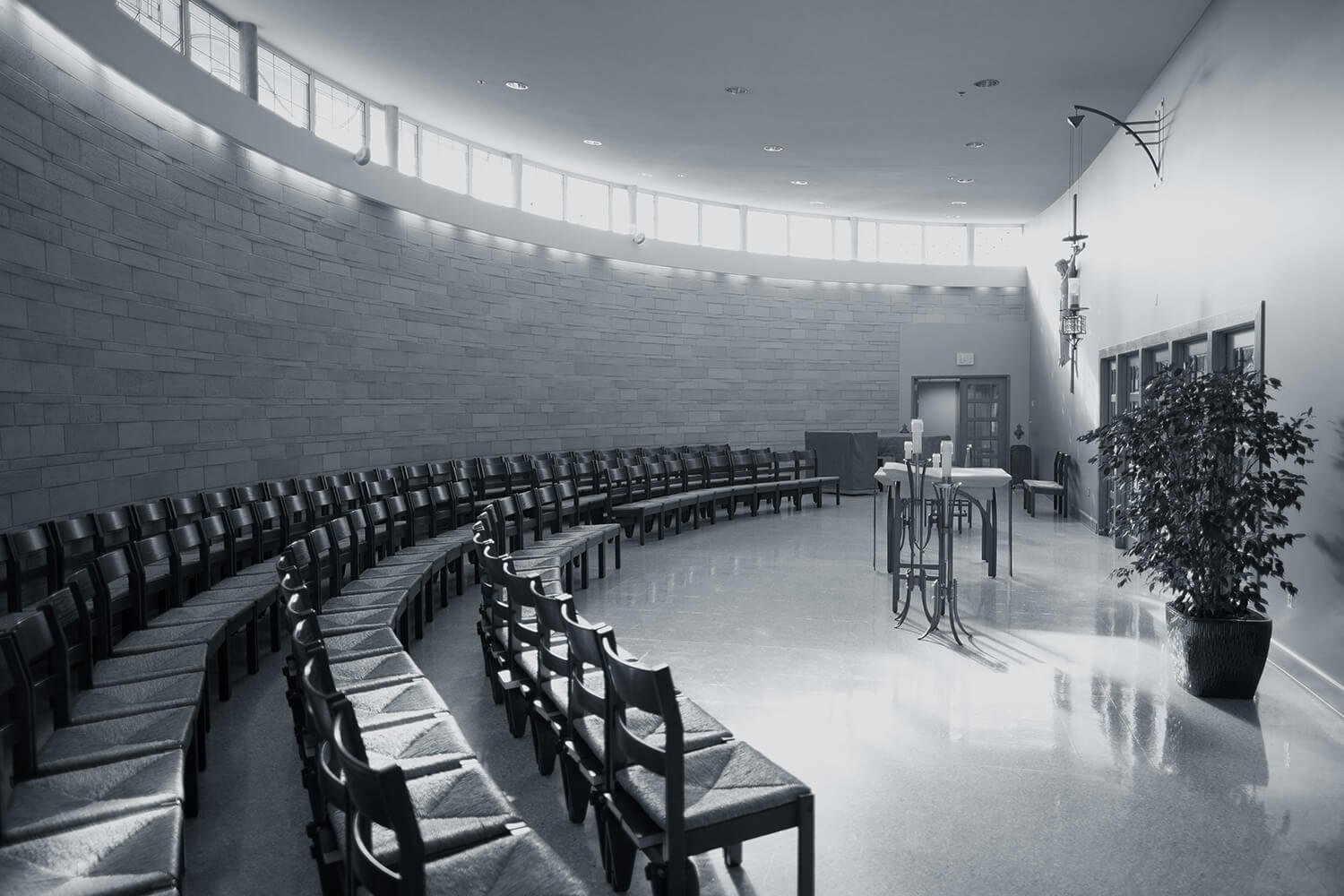
History
1863
This was the first Catholic church in Rochester, founded in 1863 by Father James Morris on the very block where the co-cathedral stands today. The first church was dedicated on December 1, 1872, and, after almost 30 years of growth, an expansion called for a new cornerstone to be laid on October 12, 1900.
With an awareness of the need for Catholic education, three new schools opened for classes on this same block in 1913, including a grade school, Saint John High School for girls and Heffron High School for boys.
Plans were formulated during the 1950s to replace the old church. The new building, built in 1956, became one of Rochester’s most distinctive architectural structures of the times. The church, built of Mankato stone, was very simple with straight lines, but was impressive and dignified in its contemporary style.
Reverend Monsignor Gerald Mahon, pastor since 1995, oversaw a major renovation of the church, which culminated in the dedication of the new space on May 19, 2002, the Feast of Pentecost. The interior of the church was turned 180 degrees, and a new chapel, gathering space, fellowship area, and peace garden were all added during the project. The parish received permission to connect with the downtown pedestrian subway, allowing patients and caregivers access to the church from the neighboring buildings of the Mayo Medical Center.
The parish is committed to upholding the Church’s rich tradition of the arts, as seen in the sculptures and stained glass throughout the space.
The final event of the Sesquicentennial took place on November 9, 2013, when Saint John Parish presented a concert premiering the piece, “What I Have Seen and Heard,” an original composition by Saint John Parish’s Director of Liturgy and Music, Sebastian Modarelli.
The work followed the journey of the church’s patron saint, Saint John the Evangelist, through some of the most moving stories of the Gospel.
Most Reverend John Quinn, bishop of Winona, was present and offered a message of gratitude and thanksgiving for all who have had a role in the history of this parish, and he recognized its vital presence as a gift to the Rochester community and the Diocese of Winona.
1881
In June 1881, Rev. William Riordan came from Chatfield to be St. John’s pastor for 31 years. The membership of the parish was at that time about 600.
During these years the growth of the parish was marked, and a need was felt for expansion. On October 12, 1900, the cornerstone was laid.
The church was completed at a cost of $60,000 in 1905. On April 27th of that year, Archbishop Ireland delivered the sermon at the Mass. Of a special interest in the church were a number of stained glass windows given by parishioners for their family members as memorials.
About this time, a group of parishioners organized St. John’s Dramatic Club for the production of amateur plays, and for many years provided the St. Patrick’s Day programs. This venture proved successful enough financially to pay for the first pipe organ installed in St. John’s Church at the cost of $3000.
In 1905 at Christmas electric lights on the Altar (the gift of a parishioner) and holy water fonts (donated by St. Joseph’s society) were used for the first time in this occasion.
1908
Rev. J. A. Cummiskey of Winona came to act as assistant at St. John’s in January of 1908. During his period, Father Cummiskey organized a club for the youth in the parish, called St. John’s Institute. The Institute provided opportunity for recreational activities as well as religious discussion.
By 1911, Father Cummiskey had been transferred. Rev. J. L. O’Connor came from Sauk Center to be the administrative pastor and he started the plans for schools to be built on the property adjoining the church.
Three new schools were completed and opened for classes in September of 1913: a grade school for all; a High School for girls’ known as St. John’s, and taught by the sisters; and the other, Heffron High School for boys.
Father O’Connor resigned in 1914; and Rev. Garret P. Murphy came to begin a pastorate for twenty five years.
Rev. Peter W. Bartholome was named pastor in 1940. During his time, Lourdes High School was begun and the rectory was completed.
In 1942, Rev. Louis D. O’Day came to St. John’s from St. Thomas’ parish in Winona. Lourdes High School was opened for classes in January 1942. In the middle of the 1950’s, Rev. O’Day, formulated plans to replace the old church building and begin an expansion program. The parish debt was paid and a building fund was started.
The building began in 1955; the architect of the new church was Edward F. Wirtz of New Ulm, Minnesota. The contractors were all from Rochester.
1957
The edifice with a seating capacity of 1200 was one of Rochester’s most distinctive architectural acquisitions at that time. The church, built of Mankato stone, was severely simple, but most impressive and dignified. The general style of the architecture was contemporary.
The first Mass in the new church was celebrated on Sunday, January 27, 1957 at 6 a.m. by Father Joseph Mountain.
Rev. Msgr. Max M. Satory became pastor on February 27, 1964. It was the 100th anniversary of St. John’s. Events for the observance were an open house for the public on September 27, a parish census, and a special centennial Thanksgiving Day Mass.
1967
By 1967, Rev. Msgr. Raymond J. Jansen was named pastor of St. John’s. Many parishioners recall the “Movement for a Better World” held in February of 1972. It was one of the largest and most inspirational spiritual events to take place at St. John’s following Vatican II.
Father Virgil Duellman, came to St. John’s in June of 1983. During his period Father Duellman reviewed the parish committees’ functions. By May 1984, he presented clearly defined responsibilities for each committee.
In 1991, Rev. James McCauley became pastor of St. John’s. During his period Father McCauley worked in developing and establishing a formal staff that supported him both administratively and ministerially.
Rev. Msgr. Gerald A. Mahon was named pastor of St. John’s in 1995. By the end of 1996 a liturgical consultant met with the Liturgical committee to provide education for liturgy and environment. In the summer of 1997 Fr. Mahon formed an enhancement committee comprised of 18 members of the parish community.
This committee with the advice and support of Sr. Jean Ersfeld, Diocesan Liturgist, began to explore the possibilities for the renovation of the sacred space.
1998
In 1998 a needs assessment survey was developed and then distributed to the parish. The results of that survey indicated that parishioners were most concerned about:
Providing a separate sacred space for small liturgical celebrations and personal prayer.
Improving the lighting and acoustics.
Providing for handicap accessibility to all areas of the parish facility.
Encouraging social gathering of the faith community.
Providing a separate area for funeral luncheons and others functions.
Providing a permanent baptismal font.
Providing additional meeting and faith formation rooms.
In response of all these concerns the committee developed a vision statement for the enhancement of the church that said:
“We believe that faith is not so much a destination as a journey, a process of growth and development that must be sustained at every step along life’s path. The Church of St. John’s must provide this faith experience for all people.
We believe the people of The Church of St. John the Evangelist wish to intensify the close community we have enjoyed through the years, which will encourage and enrich full liturgical participation of our parish community.
We believe that we must maintain a place to experience God’s tender care, to form and transform a holy people whose lives are sustained by God’s love.
Therefore, we desire:
To create a Worship Space that provides for the gathering of all around the focal points of the liturgy so they see, hear and become involved in our sacramental celebrations.
To create a Devotional Space that is separate and distinct from our worship space. It will be sacred, peaceful and inviting while providing for reservation of the Holy Eucharist and individual or small group devotion.
To create a Baptismal Space that is permanent and beautiful, reminding us of the gift of our baptismal re-birth in water.
To create a Music Space that will encourage the full and active participation of all.
To create a Gathering Space which promotes a sense of belonging to a faith family. A gathering space speaks to our ministry of hospitality, providing access to all, and welcoming everyone who enters.
To Create an Outdoor Space that is quiet, peaceful and inviting. Natural landscaping reflects sensitivity to our local environment and complements the uniqueness of our location.”
1999
In response to this vision statement in March of 1999, the architects developed the final proposal, which consisted of turning the church 180 degrees, creating a gathering space and a fellowship area in the old school gym, and adding a chapel to the 4th Ave. side of the church, available for use by church members and the hundreds of visitors who stop in from the Mayo Clinic campus.
During 2000 the School of St. John’s was renovated allowing the Church Renovation to begin in 2001. For one year, the parish community worshiped in the new gymnasium, setting up and taking down 200 chairs each weekend!
2002
The dedication celebration at the new sanctuary took place on May 19, 2002, The Feast of Pentecost. Bishop Bernard J. Harrington, Bishop of the Diocese of Winona presided at this celebration.
The renovated sanctuary provides handicap accessibility, a worship space that accommodates all, a devotional space, a permanent baptismal font, a music space, a gathering area, a chapel, an outdoor space that provides a place of rest and peace, and a subway connection with Mayo buildings.
Father Mahon in his bulletin on May 5, 2002 said “…the Enhancement Committee was formed and began meeting every other week in the summer of 1997. During the past five years, our dream has unfolded in front of us brick by brick and we are prepared to be a strong, vibrant parish community for the next 100 years.”
2018
One hundred and twenty eight years after the founding of the Diocese of Winona, Rochester had grown to become the diocese’s most populous city, and the third largest city in Minnesota, with three quarters of the diocesan population living in the area between Rochester and Mankato. To build a greater presence in Rochester, it became apparent that the diocese would be well-served by a co-cathedral.
In 2015, an initial inquiry was sent to the Vatican’s Congregation for Bishops, asking for the designation of a co-cathedral in Rochester.
The Congregation for Bishops subsequently sent the diocese requirements for the process and directed the establishment of a diocesan planning committee. This committee determined that St. John the Evangelist Church should be elevated to the status of a co-cathedral.
The co-cathedral committee, and other groups involved, considered the size of the church building, location, architecture and overall ability to function as a co-cathedral. Other factors included its proximity to the Mayo Clinic, the arts, culture, media, and industry, which provided an opportunity for further evangelization by the local Church. Also considerable was St. John the Evangelist’s status as the “mother church” of Rochester, being the oldest parish in the city.
As soon as it was determined that St. John the Evangelist would be elevated to a co-cathedral, the diocese underwent a change in name from the Diocese of Winona to the Diocese of Winona-Rochester. On June 24, 2018, the Church of St. John the Evangelist was elevated to the dignity of a co-cathedral. Bishop of Winona-Rochester Most Rev.
John M. Quinn celebrated the Mass of Elevation, with Apostolic Nuncio Most Rev. Christophe Pierre and Archbishop of St. Paul and Minneapolis Most Rev. Bernard A. Hebda as concelebrants.
Bishop Quinn blessed his new cathedra, or bishop’s chair, bearing witness to the apostolic ministry of sanctifying, teaching, and shepherding.











